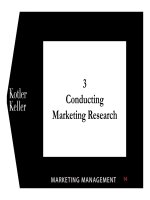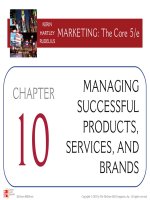Lecture Marketing metrics: Chapter 5 - Trần Nhật Minh
Bạn đang xem bản rút gọn của tài liệu. Xem và tải ngay bản đầy đủ của tài liệu tại đây (791.76 KB, 8 trang )
9/18/2015
Chapter 5:
Financial metrics
Contents
• Cost, price, revenue and profit
• Key financial indexes
Costs
1
9/18/2015
Key metrics
• Cost
◦ Variable and Fixed cost
• Margin & Contribution
◦ Unit margin
◦ Margin (%)
◦ Contribution per unit
◦ Contribution margin
• Marketing spending
Variable & Fixed Costs
• Purpose: To understand how costs change with
volume
Variable & Fixed Costs
• 𝑻𝒐𝒕𝒂𝒍 𝒄𝒐𝒔𝒕 $ = 𝑉𝑎𝑟𝑖𝑎𝑏𝑙𝑒 𝑐𝑜𝑠𝑡 𝑝𝑒𝑟 𝑢𝑛𝑖𝑡 $ ∗
𝑄𝑢𝑎𝑛𝑡𝑖𝑡𝑦 # + 𝐹𝑖𝑥𝑒𝑑 𝑐𝑜𝑠𝑡 $ =
𝑇𝑜𝑡𝑎𝑙 𝑣𝑎𝑟𝑖𝑎𝑏𝑙𝑒 𝑐𝑜𝑠𝑡 $ + 𝐹𝑖𝑥𝑒𝑑 𝑐𝑜𝑠𝑡($)
• 𝑻𝒐𝒕𝒂𝒍 𝒗𝒂𝒓𝒊𝒂𝒃𝒍𝒆 𝒄𝒐𝒔𝒕𝒔 $ = 𝑈𝑛𝑖𝑡 𝑣𝑜𝑙𝑢𝑚𝑒 # ∗
𝑉𝑎𝑟𝑖𝑎𝑏𝑙𝑒 𝑐𝑜𝑠𝑡 𝑝𝑒𝑟 𝑢𝑛𝑖𝑡 $
2
9/18/2015
Variable & Fixed Costs
• Cautions:
◦ Linear cost model does not fit every situation
◦ The classification of costs as fixed or variable depends on
context.
◦ Total cost per unit vs. Variable cost per unit
Margins &
Contributions
Margins
• Purpose: To determine the value of incremental
sales, and to guide pricing and promotion
decisions.
3
9/18/2015
Margins
• 𝑼𝒏𝒊𝒕 𝒎𝒂𝒓𝒈𝒊𝒏 $ = 𝑆𝑒𝑙𝑙𝑖𝑛𝑔 𝑝𝑟𝑖𝑐𝑒 𝑝𝑒𝑟 𝑢𝑛𝑖𝑡 $ −
𝐶𝑜𝑠𝑡 𝑝𝑒𝑟 𝑢𝑛𝑖𝑡 $
𝑈𝑛𝑖𝑡 𝑚𝑎𝑟𝑔𝑖𝑛($)
• 𝑴𝒂𝒓𝒈𝒊𝒏 % = 𝑆𝑒𝑙𝑙𝑖𝑛𝑔 𝑝𝑟𝑖𝑐𝑒 𝑝𝑒𝑟 𝑢𝑛𝑖𝑡($) =
𝑇𝑜𝑡𝑎𝑙 𝑠𝑎𝑙𝑒𝑠 𝑟𝑒𝑣𝑒𝑛𝑢𝑒 $ −𝑇𝑜𝑡𝑎𝑙 𝑐𝑜𝑠𝑡($)
𝑇𝑜𝑡𝑎𝑙 𝑠𝑎𝑙𝑒𝑠 𝑟𝑒𝑣𝑒𝑛𝑢𝑒($)
Margins
• Cautions:
◦ Unit margin vs. percentage margin
◦ What is a unit
◦ Unit cost and selling price: rebates, customer discount,
commissions can be considered as cost or as deduction
from the selling price
◦ Margin as a percentage of costs, not as selling price:
applied in certain industries.
◦ Margin vs. Markup
◦ Various costs may or may not be included
Contributions
• Purpose: to provide a rough indicator of the
earning impact of a marketing activity.
4
9/18/2015
Contributions
• 𝑪𝒐𝒏𝒔𝒕𝒓𝒊𝒃𝒖𝒕𝒊𝒐𝒏 𝒑𝒆𝒓 𝒖𝒏𝒊𝒕 $ =
𝑆𝑒𝑙𝑙𝑖𝑛𝑔 𝑝𝑟𝑖𝑐𝑒 𝑝𝑒𝑟 𝑢𝑛𝑖𝑡 $ −
𝑉𝑎𝑟𝑖𝑎𝑏𝑙𝑒 𝑐𝑜𝑠𝑡 𝑝𝑒𝑟 𝑢𝑛𝑖𝑡 $
• 𝑻𝒐𝒕𝒂𝒍 𝒄𝒐𝒏𝒕𝒓𝒊𝒃𝒖𝒕𝒊𝒐𝒏 $ = 𝑈𝑛𝑖𝑡 𝑠𝑜𝑙𝑑 # ∗
𝐶𝑜𝑛𝑡𝑟𝑖𝑏𝑢𝑡𝑖𝑜𝑛 𝑝𝑒𝑟 𝑢𝑛𝑖𝑡 $ =
𝑇𝑜𝑡𝑎𝑙 𝑟𝑒𝑣𝑒𝑛𝑢𝑒 $ − 𝑇𝑜𝑡𝑎𝑙 𝑣𝑎𝑟𝑖𝑎𝑏𝑙𝑒 𝑐𝑜𝑠𝑡𝑠($)
Marketing
spending
Marketing spending
• Purpose: to forecast marketing spending and assess
budgeting risk
• Marketing spending: total expenditure on marketing
activities. This typically includes advertising and nonprice promotion. It sometimes includes sales force
spending and may also include price promotion.
• Total, fixed, variable marketing cost.
5
9/18/2015
Marketing spending
• 𝑻𝒐𝒕𝒂𝒍 𝒎𝒂𝒓𝒌𝒆𝒕𝒊𝒏𝒈 𝒄𝒐𝒔𝒕𝒔 $ =
𝑇𝑜𝑡𝑎𝑙 𝑓𝑖𝑥𝑒𝑑 𝑚𝑎𝑟𝑘𝑒𝑡𝑖𝑛𝑔 𝑐𝑜𝑠𝑡𝑠 $ +
𝑇𝑜𝑡𝑎𝑙 𝑣𝑎𝑟𝑖𝑎𝑏𝑙𝑒 𝑚𝑎𝑟𝑘𝑒𝑡𝑖𝑛𝑔 𝑐𝑜𝑠𝑡𝑠 $
• 𝑻𝒐𝒕𝒂𝒍 𝒗𝒂𝒓𝒊𝒂𝒃𝒍𝒆 𝒎𝒂𝒓𝒌𝒕𝒊𝒏𝒈 𝒄𝒐𝒔𝒕𝒔 $ =
𝑅𝑒𝑣𝑒𝑛𝑢𝑒 $ ∗ 𝑉𝑎𝑟𝑖𝑎𝑏𝑙𝑒 𝑚𝑎𝑟𝑘𝑒𝑡𝑖𝑛𝑔 𝑐𝑜𝑠𝑡𝑠(%)
Marketing spending
• Fixed marketing cost:
◦ Sales force salaries and support
◦ Major advertising campaign, including production costs.
◦ Marketing staff
◦ Sales promotion material
◦ Cooperative advertising allowances based on prior-period
sales
Marketing spending
• Variable marketing cost:
◦ Sales commissions paid to sales force, brokers, or
manufacturer representatives.
◦ Sales bonuses contingent on reaching sales goals.
◦ Early payment terms.
◦ Coupon face-value payments and rebates, including
processing fees.
◦ Bill-backs for local campaigns, which are conducted by
retailers but reimbursed by national brand and
cooperative advertising allowances, based on current
period sales.
6
9/18/2015
Marketing &
Finance
Key financial metrics
Key financial indexes
• Profit
◦ Net profit
◦ Return On Sales (ROS)
• ROI
• NPV
• ROMI
Net profit & Return on sales
• Purpose: to measure levels and rates of
profitability
• 𝑵𝒆𝒕 𝒑𝒓𝒐𝒇𝒊𝒕 $ = 𝑆𝑎𝑙𝑒𝑠 𝑟𝑒𝑣𝑒𝑛𝑢𝑒 $ −
𝑇𝑜𝑡𝑎𝑙 𝑐𝑜𝑠𝑡𝑠 $
• 𝑹𝒆𝒕𝒖𝒓𝒏 𝒐𝒏 𝑺𝒂𝒍𝒆𝒔 % =
𝑁𝑒𝑡 𝑝𝑟𝑜𝑓𝑖𝑡($)
𝑆𝑎𝑙𝑒𝑠 𝑟𝑒𝑣𝑒𝑛𝑢𝑒($)
7
9/18/2015
Return on Investment (ROI)
• Purpose: to measure per period rates of return on
dollars invested in an economic entity
• 𝑹𝒆𝒕𝒖𝒓𝒏 𝒐𝒏 𝑰𝒏𝒗𝒆𝒔𝒕𝒎𝒆𝒏𝒕 % =
𝑁𝑒𝑡 𝑝𝑟𝑜𝑓𝑖𝑡($)
𝐼𝑛𝑣𝑒𝑠𝑡𝑚𝑒𝑛𝑡($)
• Investment:
◦ Return on Assets (ROA)
◦ Return on Net Assets (RONA)
◦ Return on Capital (ROC)
◦ Return on Invested Capital (ROIC)
◦ Return on Capital Employed (ROCE)
Evaluating multi-period
investments
• Purpose: to evaluate investments with financial consequences
spanning multiple periods.
• 𝑷𝒂𝒚𝒃𝒂𝒄𝒌 # = 𝑡ℎ𝑒 𝑛𝑢𝑚𝑏𝑒𝑟 𝑜𝑓 𝑝𝑒𝑟𝑖𝑜𝑑𝑠 𝑟𝑒𝑞𝑢𝑖𝑟𝑒𝑑 𝑡𝑜 𝑝𝑎𝑦 𝑏𝑎𝑐𝑘
𝑜𝑟 𝑟𝑒𝑡𝑢𝑟𝑛 𝑡ℎ𝑒 𝑖𝑛𝑖𝑡𝑖𝑎𝑙 𝑖𝑛𝑣𝑒𝑠𝑡𝑚𝑒𝑛𝑡
• 𝑵𝒆𝒕 𝑷𝒓𝒆𝒔𝒆𝒏𝒕 𝑽𝒂𝒍𝒖𝒆 𝑵𝑷𝑽 $ =
𝑇ℎ𝑒 𝑑𝑖𝑠𝑐𝑜𝑢𝑛𝑡 𝑣𝑎𝑙𝑢𝑒 𝑜𝑓 𝑓𝑢𝑡𝑢𝑟𝑒 𝑐𝑎𝑠ℎ 𝑓𝑙𝑜𝑤𝑠 − 𝐼𝑛𝑖𝑡𝑖𝑎𝑙 𝑖𝑛𝑣𝑒𝑠𝑡𝑚𝑒𝑛𝑡
• 𝑰𝒏𝒕𝒆𝒓𝒏𝒂𝒍 𝑹𝒂𝒕𝒆 𝒐𝒇 𝑹𝒆𝒕𝒖𝒓𝒏 𝑰𝑹𝑹 % =
𝑇ℎ𝑒𝑑𝑖𝑠𝑐𝑜𝑢𝑛𝑡 𝑟𝑎𝑡𝑒 𝑡ℎ𝑎𝑡 𝑟𝑒𝑠𝑢𝑙𝑡𝑠 𝑖𝑛 𝑎𝑛 𝑁𝑃𝑉 𝑜𝑓 𝑧𝑒𝑟𝑜
Return on Marketing
Investment (ROMI)
• Purpose: to measure the rate at which spending
on marketing contributes to profits.
• 𝑅𝑂𝑀𝐼 % =
𝑅𝑒𝑣𝑒𝑛𝑢𝑒 𝑎𝑡𝑡𝑟𝑖𝑏𝑢𝑡𝑎𝑏𝑙𝑒 𝑡𝑜 𝑚𝑎𝑟𝑘𝑒𝑡𝑖𝑛𝑔 $ ∗ 𝐶𝑜𝑛𝑡𝑟𝑖𝑏𝑢𝑡𝑖𝑜𝑛
𝑚𝑎𝑟𝑔𝑖𝑛 % −𝑀𝑎𝑟𝑘𝑒𝑡𝑖𝑛𝑔 𝑐𝑜𝑠𝑡($)
𝑀𝑎𝑟𝑘𝑒𝑡𝑖𝑛𝑔 𝑐𝑜𝑠𝑡($)
8









